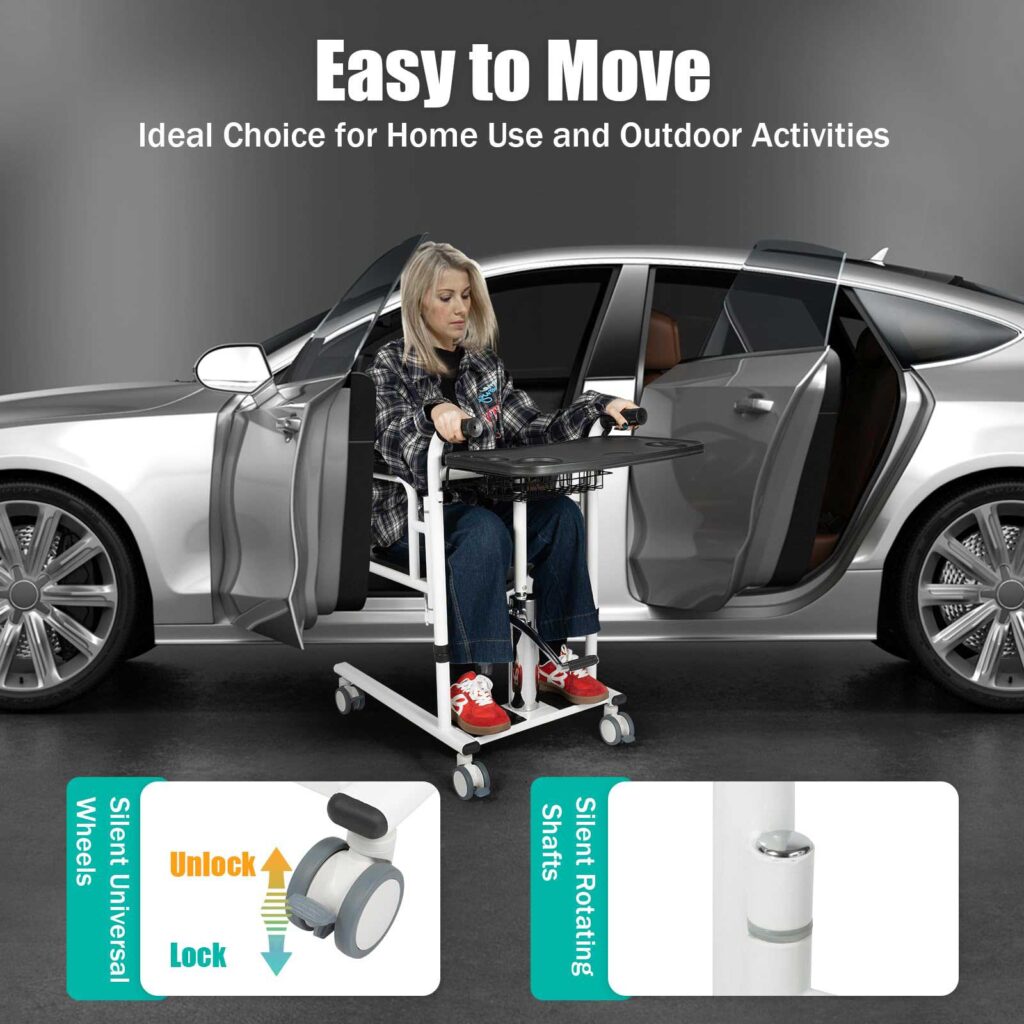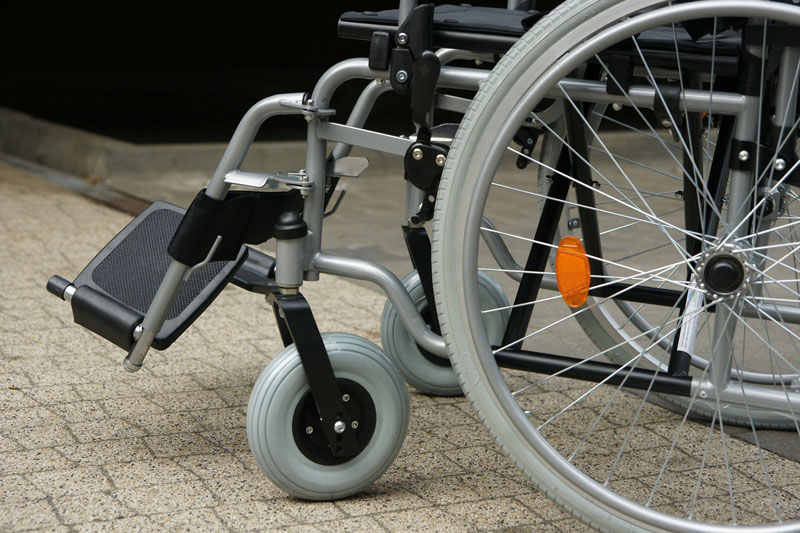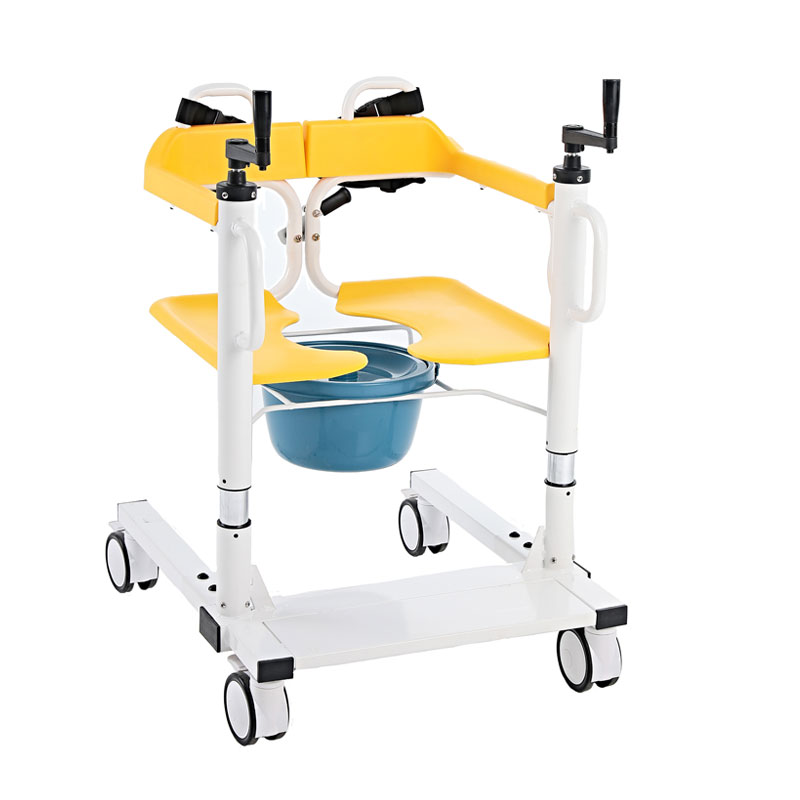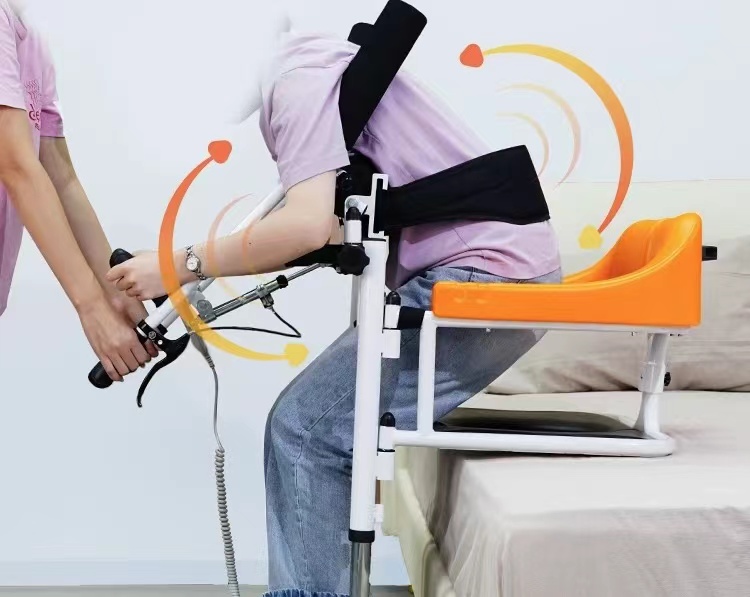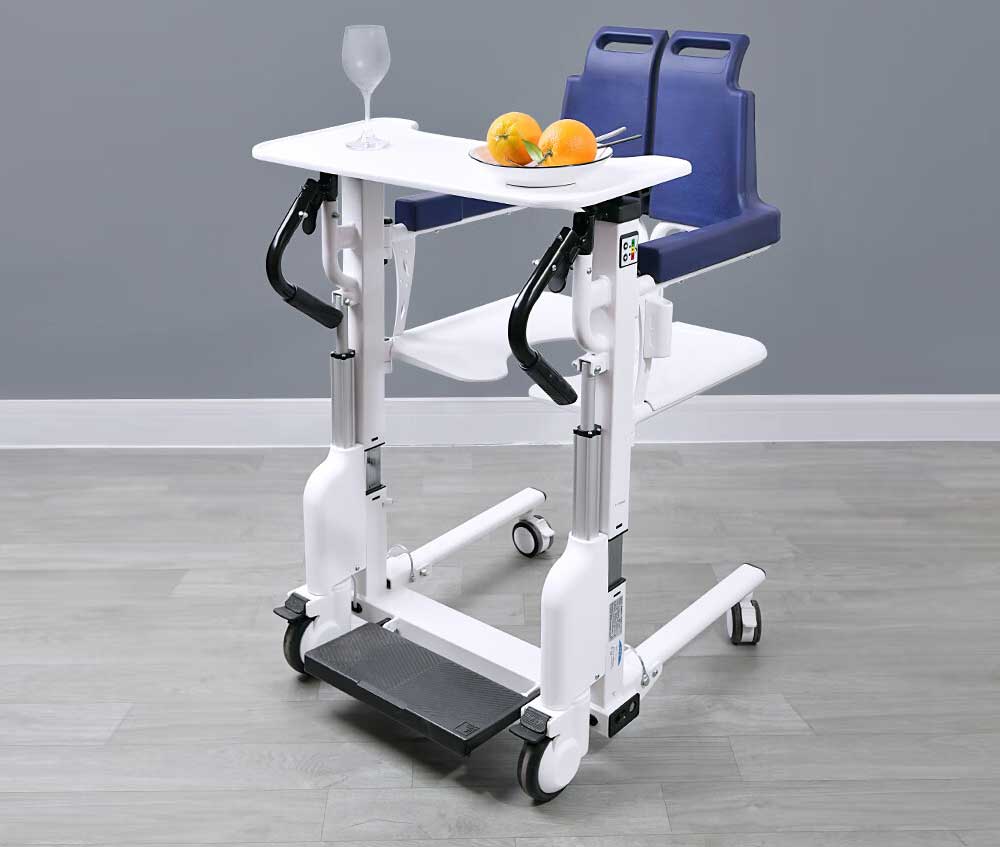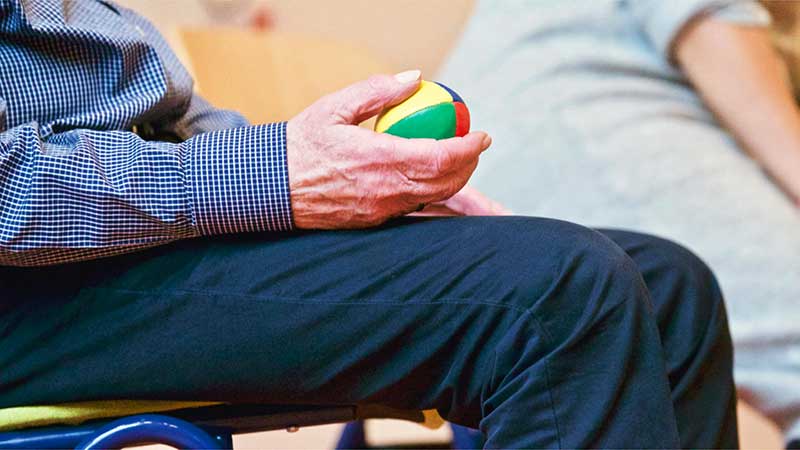As we age or face mobility challenges due to disabilities, everyday tasks like moving from a bed to a chair or getting in and out of a car can become daunting.
For elderly individuals and those with disabilities, maintaining independence and safety during these transfers is crucial. This is where mobility transfer chairs come into play. These specialized chairs are designed to bridge the gap between standard wheelchairs and complete immobility, offering a practical solution for safe and comfortable transfers.
Mobility transfer chairs are not just tools for convenience; they are essential aids that enhance the quality of life for seniors and disabled individuals. According to the World Health Organization (WHO), over 1 billion people worldwide live with some form of disability, and many of them require assistive devices like transfer chairs to perform daily activities safely and independently.
Similarly, the National Institute on Aging (NIA) highlights that mobility aids, including transfer chairs, can significantly reduce the risk of falls among the elderly, which is a leading cause of injury in this population.
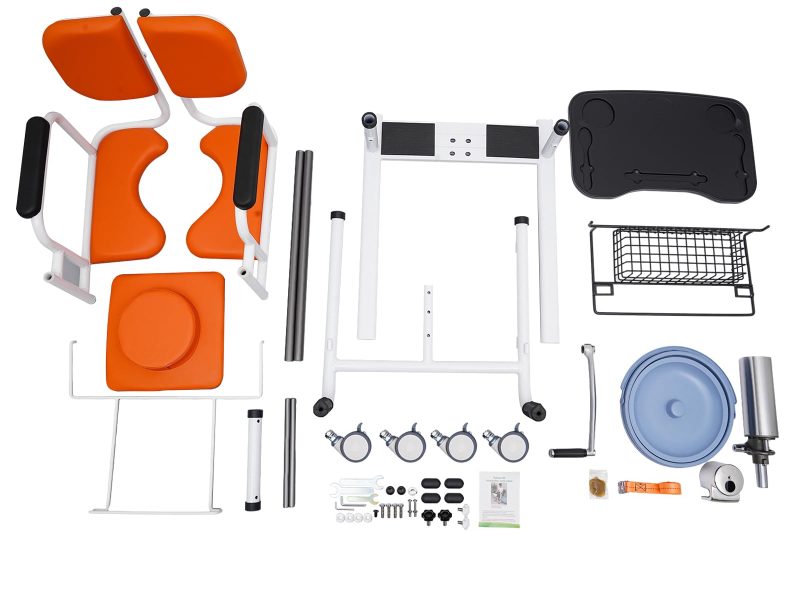
1. What is a Mobility Transfer Chair?
A mobility transfer chair is a specialized assistive device designed to help individuals with limited mobility move safely and comfortably from one place to another.
Unlike traditional wheelchairs, which are primarily used for continuous mobility, transfer chairs are specifically engineered to facilitate short-distance transfers, such as moving from a bed to a chair, a chair to a car, or even a wheelchair to a toilet. These chairs are particularly beneficial for elderly individuals, seniors, and people with disabilities who may struggle with balance, strength, or coordination during such transitions.

- Key Features
Mobility transfer chairs are designed with several features that make them ideal for safe and efficient transfers:
Lightweight Construction: Most transfer chairs are made from lightweight materials like aluminum, making them easy to maneuver and transport. The aluminum is especially helpful for caregivers who need to move the chair frequently.
Compact Design: Transfer chairs are often more compact than standard wheelchairs, allowing them to fit into tight spaces, such as small bathrooms or car interiors.
Adjustable Components: Many models come with adjustable armrests, footrests, and seat heights to accommodate users of different sizes and needs.
Safety Features: Features like locking brakes, secure straps, and non-slip surfaces ensure stability and reduce the risk of accidents during transfers.
- How Transfer Chairs Differ from Standard Wheelchairs
While both transfer chairs and wheelchairs serve individuals with mobility challenges, they are designed for different purposes.
- Standard wheelchairs are built for prolonged use and mobility over longer distances, often featuring large rear wheels for self-propulsion or caregiver assistance.
- In contrast, transfer chairs are optimized for short-distance transfers and are typically smaller, lighter, and easier to handle in confined spaces.
According to a report by the National Library of Medicine, assistive devices like transfer chairs can significantly improve the quality of life for individuals with mobility impairments by reducing dependency on caregivers and minimizing the risk of injury during transfers.
Additionally, the American Occupational Therapy Association (AOTA) emphasizes that using the right assistive equipment, such as transfer chairs, can help maintain independence and dignity for elderly and disabled individuals.
- Who Can Benefit from a Mobility Transfer Chair?
Mobility transfer chairs are versatile tools that can benefit a wide range of users, including:
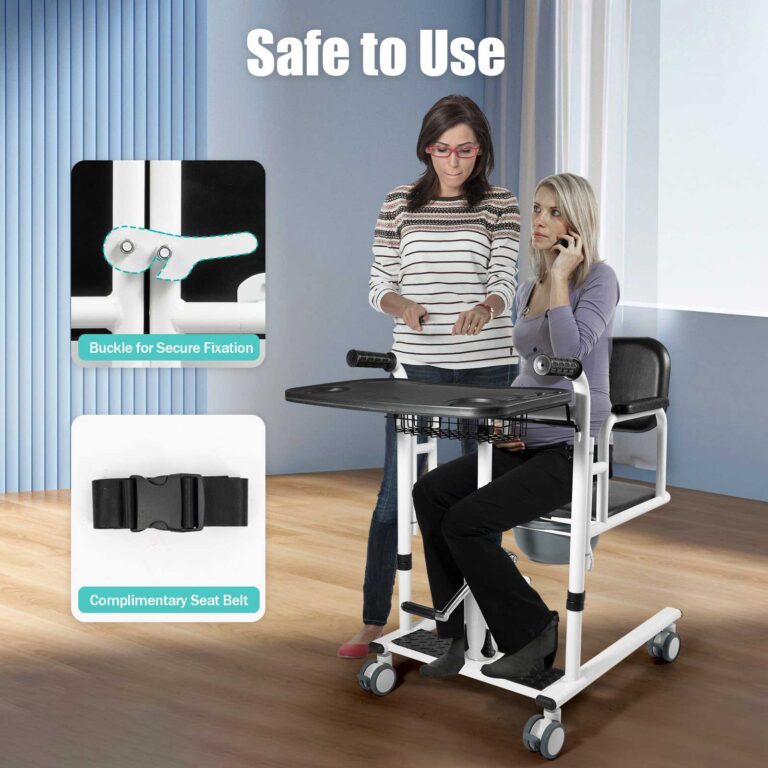
Elderly Individuals: Seniors who experience difficulty standing or walking due to age-related conditions like arthritis or muscle weakness.
Disabled Individuals: People with physical disabilities, such as spinal cord injuries, multiple sclerosis, or cerebral palsy, who require assistance with transfers.
Post-Surgery Patients: Individuals recovering from surgeries, such as hip or knee replacements, who need temporary support during transfers.
Caregivers: Family members or professional caregivers who assist with daily transfers and seek to reduce physical strain.
A mobility transfer chair is a practical and essential tool for anyone facing challenges with mobility transitions. Its thoughtful design and safety features make it an invaluable aid for both users and caregivers, ensuring comfort and security during every transfer.
2. Benefits of Transfer Chairs for Elderly and Disabled Individuals
Mobility transfer chairs are more than just convenient tools—they are transformative aids that significantly improve the quality of life for elderly and disabled individuals.
These chairs address a wide range of challenges associated with limited mobility, offering both practical and emotional benefits. Below, we explore the key advantages of using transfer chairs for seniors and individuals with disabilities.
- Enhanced Safety During Transfers
One of the most critical benefits of transfer chairs is the increased safety they provide during transfers. Moving from a bed to a chair or a chair to a car can be risky for individuals with limited mobility, as it often involves balancing and shifting weight, which can lead to falls.
According to the Centers for Disease Control and Prevention (CDC), falls are the leading cause of injury among older adults, with millions of emergency room visits each year. Transfer chairs mitigate this risk by providing stable support and secure seating during transitions, reducing the likelihood of accidents.
- Reduced Strain on Caregivers
Caregivers, whether family members or professionals, often face physical strain when assisting with transfers. Lifting or supporting an individual during a transfer can lead to back injuries or muscle strain for the caregiver.
Transfer chairs are designed to minimize this burden by allowing smoother, more controlled movements. A study published in the National Library of Medicine highlights that using assistive devices like transfer chairs can reduce caregiver fatigue and improve the overall caregiving experience.
- Improved Comfort and Support
Many transfer chairs are equipped with padded seats, adjustable armrests, and ergonomic designs to ensure maximum comfort for users.
For elderly individuals with conditions like arthritis or chronic pain, these features can make a significant difference in their daily lives.
Additionally, transfer chairs provide proper posture support, which is essential for individuals who spend extended periods sitting.
- Increased Independence and Dignity
For many elderly and disabled individuals, relying on others for mobility can feel disempowering. Transfer chairs enable users to participate more actively in their daily routines, fostering a sense of independence and dignity. The World Health Organization (WHO) emphasizes that assistive devices like transfer chairs play a crucial role in promoting inclusion and autonomy for people with disabilities.
- Portability and Versatility
Transfer chairs are often lightweight and foldable, making them easy to transport and store. This portability allows users to maintain their mobility in various settings, whether at home, in a hospital, or while traveling.
For example, a compact transfer chair can be easily loaded into a car for medical appointments or family outings, ensuring that users remain mobile and engaged in their communities.
- Cost-Effective Solution
Compared to more complex mobility aids, transfer chairs are relatively affordable and offer excellent value for their functionality.
They provide a cost-effective solution for individuals and families who need reliable support without the high costs associated with advanced medical equipment.
- Emotional and Psychological Benefits
Beyond the physical advantages, transfer chairs can also have a positive impact on mental health. By enabling safer and more comfortable transfers, these chairs reduce anxiety and stress associated with mobility challenges.
This, in turn, can improve overall well-being and quality of life for users and their caregivers.
3. Types of Mobility Transfer Chairs
Mobility transfer chairs come in various designs and configurations to meet the diverse needs of elderly and disabled individuals. Understanding the different types of transfer chairs can help you choose the one that best suits your specific requirements. Below, we explore the main categories of mobility transfer chairs, their unique features, and the scenarios in which they are most beneficial.
- Transfer Chairs for Elderly
Transfer chairs designed for elderly individuals focus on providing comfort, safety, and ease of use. These chairs are ideal for seniors who may have mild to moderate mobility limitations but can still assist with transfers to some extent. Key features often include:
Padded Seats and Backrests: For added comfort during prolonged sitting.
Lightweight Frames: To make the chair easy to maneuver for both the user and the caregiver.
Adjustable Armrests and Footrests: To accommodate different body types and preferences.
These chairs are particularly useful for seniors who need assistance moving between rooms or getting in and out of vehicles. According to the National Institute on Aging (NIA), using appropriate mobility aids can help seniors maintain their independence and reduce the risk of falls.
- Disabled Transfer Chairs
Disabled transfer chairs are designed for individuals with more severe mobility limitations, such as those with spinal cord injuries, multiple sclerosis, or cerebral palsy. These chairs often include specialized features like:
Reinforced Frames: To support higher weight capacities.
Secure Straps and Harnesses: To ensure the user remains safely seated during transfers.
Tilt-in-Space Mechanisms: To help caregivers reposition the user without causing strain or discomfort.
These chairs are commonly used in both home and clinical settings to assist with complex transfers. The Christopher & Dana Reeve Foundation emphasizes the importance of using specialized equipment to improve the quality of life for individuals with severe disabilities.
- Patient Transfer Chairs
Patient transfer chairs are typically used in hospitals, nursing homes, and other healthcare facilities. They are designed to meet the rigorous demands of medical environments and often feature:
Medical-Grade Materials: For durability and easy cleaning.
Height-Adjustable Seats: To align with beds, wheelchairs, or examination tables.
Swivel Seats: To facilitate easier transfers in tight spaces.
These chairs are essential for healthcare providers who need to move patients safely and efficiently. A study published in the National Library of Medicine highlights the role of patient transfer chairs in reducing the risk of injury to both patients and caregivers during medical transfers.
- Lightweight and Foldable Transfer Chairs
For individuals and families who need a portable solution, lightweight and foldable transfer chairs are an excellent option. These chairs are designed for easy transport and storage, making them ideal for travel or occasional use. Key features include:
Compact Design: To fit into small spaces, such as car trunks or closets.
Quick-Folding Mechanisms: For easy setup and breakdown.
Durable Yet Lightweight Materials: To ensure portability without compromising strength.
These chairs are perfect for families who want a versatile mobility aid that can be used in multiple settings. The American Occupational Therapy Association (AOTA) recommends portable transfer chairs for individuals who need mobility support on the go.
- Bariatric Transfer Chairs
Bariatric transfer chairs are designed to accommodate individuals with higher weight capacities. These chairs feature:
Reinforced Frames: To support weights of 300 pounds or more.
Wide Seats and Backrests: For added comfort and stability.
Heavy-Duty Casters: To ensure smooth movement even under heavier loads.
These chairs are essential for ensuring safety and comfort for larger individuals during transfers. The Obesity Action Coalition (OAC) underscores the importance of using appropriately sized mobility aids to prevent injuries and promote dignity.
4. Key Features to Look for in a Mobility Transfer Chair
Choosing the right mobility transfer chair is essential to ensure safety, comfort, and ease of use for both the user and the caregiver. With so many options available, it can be overwhelming to determine which features are most important. To help you make an informed decision, we’ve compiled a list of key features to look for when selecting a mobility transfer chair.
- Adjustable Armrests and Footrests
Adjustable components are crucial for ensuring a proper fit and maximum comfort. Look for transfer chairs with:
Height-Adjustable Armrests: These allow users to position their arms comfortably, reducing strain on the shoulders and back.
Swing-Away or Removable Footrests: These make it easier for users to get in and out of the chair, especially when transferring to or from a bed or car.
According to the American Occupational Therapy Association (AOTA), adjustable features are essential for customizing mobility aids to individual needs, which can significantly improve user comfort and safety.
- Padded Seats and Backrests
Comfort is a top priority, especially for individuals who spend extended periods sitting. Padded seats and backrests provide:
Pressure Relief: Reducing the risk of pressure sores, particularly for users with limited mobility.
Enhanced Support: Ensuring proper posture and reducing discomfort during prolonged use.
The National Pressure Ulcer Advisory Panel (NPUAP) emphasizes the importance of pressure-relieving features in mobility aids to prevent skin breakdown and improve overall comfort.
- Lightweight and Durable Materials
The material of the transfer chair affects both its portability and longevity. Key considerations include:
Lightweight Frames: Typically made from aluminum or other lightweight metals, these make the chair easier to maneuver and transport.
Durable Construction: Ensures the chair can withstand regular use without compromising safety.
The World Health Organization (WHO) highlights that lightweight and durable mobility aids are essential for maintaining independence and ensuring long-term usability.
- Safety Features
Safety is paramount when selecting a transfer chair. Important safety features to look for include:
Locking Brakes: To keep the chair stationary during transfers.
Non-Slip Surfaces: On the seat and footrests to prevent slipping.
Secure Straps or Harnesses: To keep the user safely seated during transfers.
The Centers for Disease Control and Prevention (CDC) recommends using mobility aids with robust safety features to reduce the risk of falls and injuries.
- Portability and Storage
For individuals and families who need a versatile solution, portability is a key factor. Look for chairs with:
Foldable Designs: For easy storage and transport.
Compact Frames: To fit into small spaces, such as car trunks or closets.
The American Physical Therapy Association (APTA) notes that portable mobility aids are ideal for users who need flexibility in different environments, such as at home, in the car, or while traveling.
- Weight Capacity
Ensure the transfer chair can safely support the user’s weight. Most standard chairs support up to 250-300 pounds, while bariatric models are designed for higher weight capacities. Always check the manufacturer’s specifications to ensure the chair meets your needs.
- Compatibility with Other Mobility Aids
Some transfer chairs are designed to work seamlessly with other assistive devices, such as transfer boards or hoists. This compatibility can make transfers smoother and safer for both the user and the caregiver.
- Ease of Cleaning
For hygiene and maintenance, consider chairs with:
Waterproof or Wipeable Materials: For easy cleaning, especially in medical or caregiving settings.
Removable Cushions: To allow for thorough cleaning or replacement.
5. How to Choose the Right Transfer Chair
Selecting the right mobility transfer chair is a critical decision that can significantly impact the comfort, safety, and independence of elderly or disabled individuals. With so many options available, it’s essential to consider several factors to ensure the chair meets the user’s specific needs. Here’s a comprehensive guide to help you make the best choice.
- Assess the User’s Mobility Level
The first step in choosing a transfer chair is understanding the user’s mobility capabilities. Consider the following:
Can the user assist with transfers? If the user can partially support their weight, a standard transfer chair with swing-away footrests and adjustable armrests may suffice.
Does the user require full assistance? For individuals with severe mobility limitations, a chair with additional safety features like secure straps or tilt-in-space mechanisms may be necessary.
The American Occupational Therapy Association (AOTA) recommends evaluating the user’s physical abilities and consulting with a healthcare professional to determine the most suitable mobility aid.
- Consider Weight Capacity
Transfer chairs come with varying weight capacities, typically ranging from 250 to 500 pounds. It’s crucial to choose a chair that can safely support the user’s weight. For example:
Standard Chairs: Suitable for users weighing up to 250-300 pounds.
Bariatric Chairs: Designed for users with higher weight capacities, often up to 500 pounds.
The Obesity Action Coalition (OAC) emphasizes the importance of selecting equipment that accommodates the user’s size to ensure safety and comfort.
- Consider Weight Capacity
Portability is a key factor, especially if the chair will be used in multiple locations or for travel. Look for:
Lightweight Materials: Aluminum frames are ideal for easy lifting and transport.
Foldable Designs: Chairs that fold compactly are easier to store and transport in vehicles.
The American Physical Therapy Association (APTA) highlights the benefits of portable mobility aids for users who need flexibility in different environments.
- Consider Weight Capacity
Comfort is essential, particularly for individuals who spend extended periods in the chair. Key features to look for include:
Padded Seats and Backrests: To reduce pressure and prevent sores.
Adjustable Armrests and Footrests: For a customized fit and added comfort.
Ergonomic Design: To promote proper posture and reduce strain.
The National Pressure Ulcer Advisory Panel (NPUAP) stresses the importance of pressure-relieving features in preventing skin breakdown and enhancing comfort.
- Consider Weight Capacity
Safety should always be a top priority when selecting a transfer chair. Essential safety features include:
Locking Brakes: To keep the chair stationary during transfers.
Non-Slip Surfaces: On the seat and footrests to prevent slipping.
Secure Straps or Harnesses: To keep the user safely seated during transfers.
The Centers for Disease Control and Prevention (CDC) recommends using mobility aids with robust safety features to reduce the risk of falls and injuries.
- Consider Weight Capacity
If the user relies on other assistive devices, such as transfer boards or hoists, ensure the chair is compatible with these tools. This compatibility can make transfers smoother and safer for both the user and the caregiver.
- Consider Weight Capacity
Transfer chairs are available at various price points, from budget-friendly options to premium models with advanced features. While it’s important to stay within your budget, prioritize quality and safety over cost. Investing in a durable, well-designed chair can save money in the long run by reducing the need for replacements or repairs.
- Consider Weight Capacity
Before making a purchase:
Read User Reviews: Look for feedback from individuals with similar needs to gauge the chair’s performance and reliability.
Test the Chair: If possible, try out the chair in person to ensure it meets your comfort and usability requirements.
- Consider Weight Capacity
A healthcare provider, such as an occupational therapist or physical therapist, can offer valuable insights and recommendations based on the user’s medical condition and mobility challenges. They can also help you navigate insurance coverage or funding options for mobility aids.
6. Tips for Using Mobility Transfer Chairs Safely
Mobility transfer chairs are invaluable tools for enhancing the independence and safety of elderly and disabled individuals. However, improper use can lead to accidents or injuries for both the user and the caregiver. To ensure safe and effective use, follow these essential tips for operating mobility transfer chairs.
- Consider Weight Capacity
Positioning the Chair: Always ensure the transfer chair is locked in place using the brakes before attempting a transfer. Align the chair as close as possible to the bed, toilet, or car seat to minimize the distance the user needs to move.
Assisting the User: If the user can assist with the transfer, encourage them to use their stronger side to push or pivot. For those who require full assistance, caregivers should use proper lifting techniques to avoid strain or injury.
Using Transfer Aids: Tools like transfer boards or belts can make the process smoother and safer. The National Institute on Aging (NIA) recommends using assistive devices to reduce the risk of falls during transfers.
- Consider Weight Capacity
Use Safety Straps: Secure the user with the chair’s safety straps or harnesses to prevent slipping or falling during movement.
Check Footrests: Ensure the user’s feet are properly placed on the footrests to avoid tripping or dragging.
Adjust Armrests: Make sure the armrests are in the correct position to provide support and stability.
The Centers for Disease Control and Prevention (CDC) emphasizes the importance of securing users in mobility aids to prevent accidents.
- Consider Weight Capacity
Sit Upright: Encourage the user to sit upright with their back against the chair’s backrest to maintain proper posture and reduce the risk of pressure sores.
Avoid Slouching: Use cushions or padding if necessary to provide additional support and comfort.
The National Pressure Ulcer Advisory Panel (NPUAP) highlights the role of proper posture in preventing pressure injuries, especially for individuals with limited mobility.
- Consider Weight Capacity
Check for Wear and Tear: Inspect the chair regularly for loose screws, damaged wheels, or worn-out parts. Replace or repair any faulty components immediately.
Test the Brakes: Ensure the locking brakes are functioning correctly before each use.
Clean the Chair: Keep the chair clean and free from debris to maintain its functionality and hygiene.
The World Health Organization (WHO) recommends routine maintenance of assistive devices to ensure their safety and longevity.
- Consider Weight Capacity
Indoor Use: Transfer chairs are typically designed for smooth, flat surfaces. Avoid using them on uneven or slippery floors.
Outdoor Use: If using the chair outdoors, ensure the wheels are suitable for rough terrain. Some models come with larger, more durable wheels for outdoor use.
The American Physical Therapy Association (APTA) advises using mobility aids on surfaces they are designed for to prevent accidents.
- Consider Weight Capacity
Provide Proper Training: Caregivers should be trained on how to use the transfer chair safely, including proper lifting techniques and how to operate the chair’s features.
Educate the User: If the user can assist with transfers, teach them how to use the chair effectively and safely.
The American Occupational Therapy Association (AOTA) emphasizes the importance of training to ensure safe and effective use of mobility aids.
- Consider Weight Capacity
Respect Weight Limits: Never exceed the chair’s weight capacity, as this can compromise its stability and safety.
Distribute Weight Evenly: Ensure the user is seated properly and that any additional items (e.g., bags or equipment) are evenly distributed.
The Obesity Action Coalition (OAC) warns that overloading mobility aids can lead to structural failure and increase the risk of injury.
- Consider Weight Capacity
Have a Backup Plan: In case the chair malfunctions or the user experiences difficulty during a transfer, have a backup plan or alternative assistance available.
Keep Emergency Contacts Handy: Ensure caregivers and users have access to emergency contacts in case of an accident.
Mobility transfer chairs are more than just practical tools—they are lifelines for elderly and disabled individuals, offering a bridge to greater independence, safety, and comfort.
Whether used at home, in healthcare facilities, or while traveling, these chairs play a vital role in improving the quality of life for users and easing the burden on caregivers. By providing stable support during transfers, reducing the risk of falls, and enhancing overall mobility, transfer chairs empower individuals to maintain their dignity and engage more fully in daily activities.
It’s important to remember that selecting the right transfer chair is not just about functionality—it’s about finding a solution that aligns with the user’s unique needs and lifestyle. Consulting with healthcare professionals, reading user reviews, and testing chairs before purchasing can help ensure you make the best choice.
Ultimately, mobility transfer chairs are a testament to how thoughtful design and innovation can transform lives. By investing in the right chair, you’re not just purchasing a piece of equipment; you’re investing in safety, comfort, and independence for yourself or your loved ones.
Ageally hope this guide has provided valuable insights and practical advice to help you navigate the world of mobility transfer chairs. If you have any questions or would like to share your experiences, feel free to leave a comment below. For further reading, check out our related articles on mobility aids and caregiving tips.
